DOI: https://doi.org/10.1016/j.aohep.2020.08.072
Karla MacDonald-Ramos a, Layla Michán b, Alejandra Martínez-Ibarra a, Marco Cerbón a
aUnidad de Investigación en Reproducción Humana, Instituto Nacional de Perinatología “Isidro Espinosa de los Reyes” – Facultad de Química, Universidad Nacional Autónoma de México, CDMX, 11000, Mexico bFacultad de Ciencias, Universidad Nacional Autónoma de México, CDMX, 04510, Mexico
Abstract
Silymarin is obtained from the Milk thistle plant Silybum marianum and has been used over the centuries to treat principally liver disease, although it has also been studied for its beneficial effects in cardioprotection, neuroprotection, immune modulation, and cancer among others. Importantly, silymarin’s active component silybin is a flavonolignan that exhibits different activities such as; scavenger, anti-oxidant, anti-inflammatory, and recently revealed, insulin-sensitizing properties which have been explored in clinical trials in patients with insulin resistance. In this review, we summarize the most relevant research of silymarin’s effect on lipid and carbohydrate metabolism, focusing the attention on insulin resistance, which is well known to play a crucial role in metabolic disease progression.


